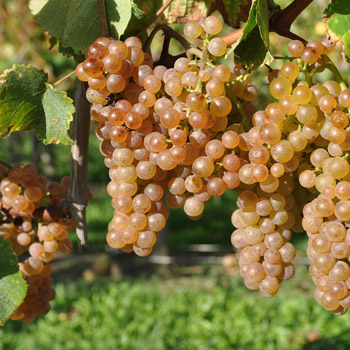Vineyards: Jurancon & Béarn
Jurançon
The vineyards amount to 1200 hectares of vines spread out over 25 communes between the Gave de Pau and Oloron. Our 220 cooperators work 750 ha of vineyards where they grow Gros Manseng and Petit Manseng grape varietals, the two grapes of our iconic name.
The subsoil consists of puddingstone (conglomerate of pebbles bonded by a calcareous sediment forming boulders) which promotes drainage and is favourable to the cultivation of grapes. The vineyard terrain is typical to Pyrenean piedmont: the vines are planted in the direction of the slope and face south, to be sheltered from the westerly winds. Where the slope is too steep, the vines have been planted on flats carved out of the mountainside allowing access to exceptional soils. This technique is called Terracing. The vine is pruned following the Guyot style, single or double. The trunk, or stock of each vine supports two branches, each bearing vegetation. As these are high-trained vines, the vegetation is directed upward so that the foliage may reach a height of 2.3 metres.
Béarn
The zone pertaining to the Béarn appellation covers 35 municipalities, and its surface area is about 200 ha. Our 130 cooperatives work mainly three grape varieties: Tannat, Cabernet Franc (locally called Bouchy) and Cabernet Sauvignon.
There are 2 types of soils:
-The Lowland vineyards span the old river bed of the Gave de Pau, and are planted in rocky, filtering soils.
-Vineyards on gently sloping hills that protect the vine against the wind and offer good southern and southeastern exposure.
The vines are pruned single Guyot (Tannat) and double Guyot (Cabernet Franc and Cabernet Sauvignon), and are high-trained.







 Gros Manseng and Petit Manseng varietals make up 99% of the vines in the Jurancon area. These are local grape varieties specific to the area and well adapted to the climatic conditions; the fruit grows very high above the ground to avoid spring frosts and the grapes are very resistant. Gros Manseng grapes are the basis for the dry Jurancon and young moelleux Jurancon wines. The Petit Manseng varietal has smaller grapes with thicker skin, which makes it well adapted to raisining (passerillage), and produces the renowned sweet wines perfect for storage. Other varietals are also grown, including Petit Courbu, Gros Courbu, Courbu, Lauzet and Camaralet. Cabernet Franc, Cabernet Sauvignon and Tannat are the three varietals of the Béarn appellation Reds and Rosés. The topography of the Jurancon appellation area is jagged and uneven, the soils containing Jurancon puddingstone composed of limestone pebbles.
Gros Manseng and Petit Manseng varietals make up 99% of the vines in the Jurancon area. These are local grape varieties specific to the area and well adapted to the climatic conditions; the fruit grows very high above the ground to avoid spring frosts and the grapes are very resistant. Gros Manseng grapes are the basis for the dry Jurancon and young moelleux Jurancon wines. The Petit Manseng varietal has smaller grapes with thicker skin, which makes it well adapted to raisining (passerillage), and produces the renowned sweet wines perfect for storage. Other varietals are also grown, including Petit Courbu, Gros Courbu, Courbu, Lauzet and Camaralet. Cabernet Franc, Cabernet Sauvignon and Tannat are the three varietals of the Béarn appellation Reds and Rosés. The topography of the Jurancon appellation area is jagged and uneven, the soils containing Jurancon puddingstone composed of limestone pebbles.